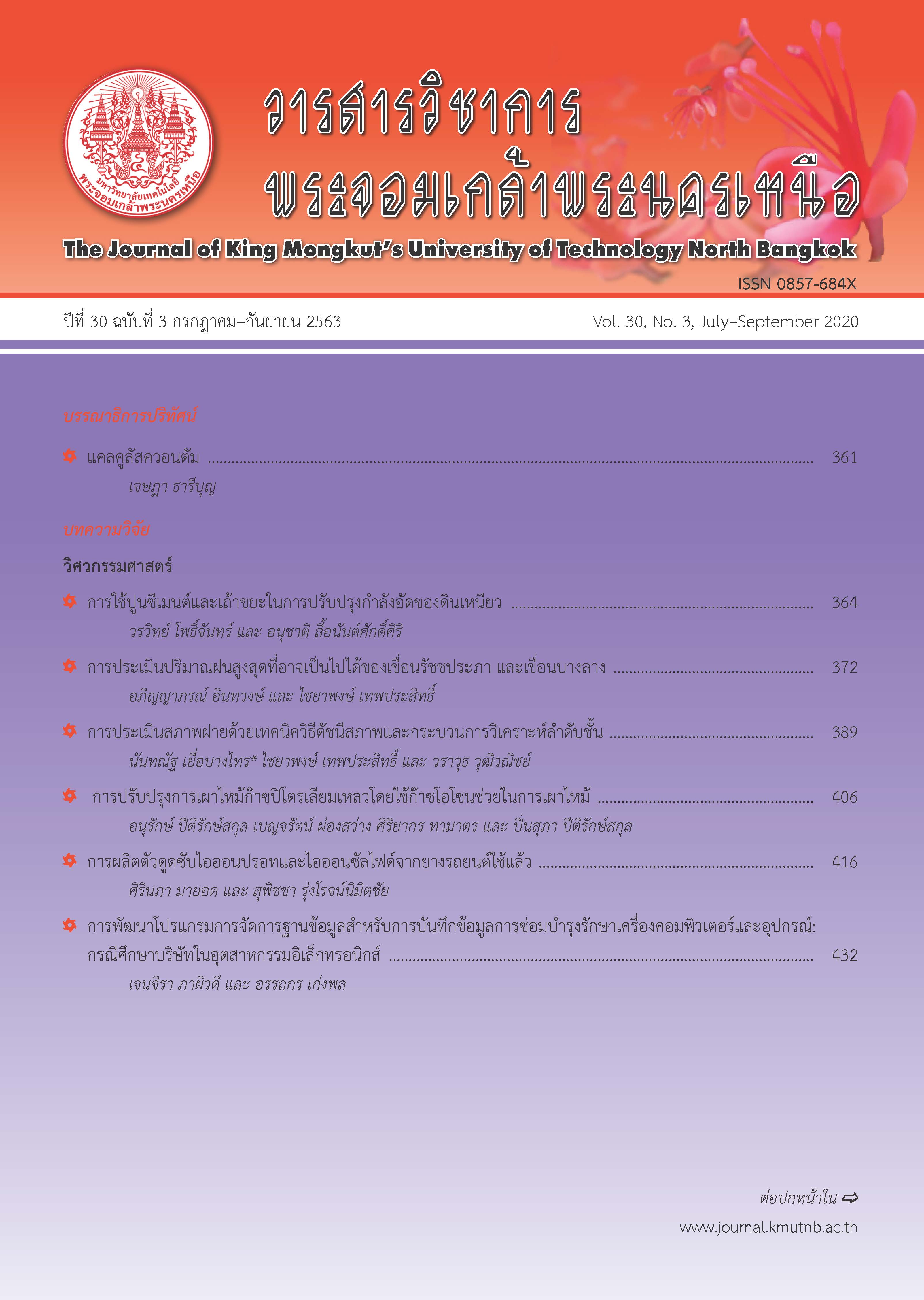Weir Condition Assessment by Condition Index Method and Analytic Hierarchy Process
Main Article Content
Abstract
Since there is no clear practical approach for the inspection and assessment of the weir condition, this study proposes an approach for assessment of weir condition. There were 58 weirs selected as the case study. By this assessment approach, the weir was divided into 5 main components (Upstream Protection Section, Upstream Concrete Section, Control Section, Downstream Concrete Section and Downstream Protection Section), 16 sub-components and 1 of the sub-components are Sluice Gate/Sand Sluice which was divided into 4 minor sub-components. The conditions of each sub-component were visually assessed by the damage conditions due to erosion, settlement, cracking, etc. categorized by 10 damage conditions defined by this approach. There were 4 levels of damage condition classified by scores 1) to 4: 1 is a perfect or the normal condition; 2) is minor damage; 3) is In the damage condition that special monitoring is required, but a repair can be postponed; and 4) is a seriously damaged condition affecting safety operation and immediate repair is required. The scores from the weir damage assessment were evaluated by 4 weir stability criteria, 1) including stability against Piping, 2) Sliding, 3) Overturning and 4) Bearing Capacity. The Analytic Hierarchy Process (AHP) was used to determine the priority weights of the criteria and various weir components and sub-components using 9 expert opinions. Finally, the weir condition index was calculated from the total a sum of product between the condition, damage scores and weights of criteria and/or components and in each level of the hierarchy. The assessment results showed that Section 1 (Upstream Protection Section) and Section 5 (Downstream Protection Section) got higher priority weight than the other 3 main components. The condition index study of 58 weirs showed that there were 52 weirs with the condition index in the range of 3.00–3.94 indicating minor damage and the other 6 weirs having the condition index in the range of 2.57–2.98 indicating the damage being started and special monitoring and evaluation required. Furthermore, the research result shows that the weir condition index developed in this study is useful to classify the conditions of the weir, whether it is in good condition or any components/sub-components require repair and the weir condition index can be used for budget allocation for repairing and improving the weir condition.
Article Details
The articles published are the opinion of the author only. The author is responsible for any legal consequences. That may arise from that article.
References
[2] S. Soralump, Dam Safety Engineering for Design and Maintenance. Bangkok: Kasetsart University Press, 2012 (in Thai).
[3] T. L. Saaty, The Analytic Hierarchy Process. Mcgraw-Hill, 1980.
[4] T. L. Saaty, Multicriteria Decision Making: The Analytic Hierarchy Process, 2nd ed., Pittsburgh: RWS Publications, 1990.
[5] S. H. Ghodsypour and C. O'Brien, “A decision support system for supplier selection using an integrated analytic hierarchy process and linear programming,” International Journal of Production Economics, vol. 56, no. 1, pp. 199–212, 1998.
[6] L. Benyoucef, H. Ding, and X. Xie, “Supplier Selection Problem: Selection Criteria and Methods,” Unite de recherche INRIA Lorraine, Nancy Cedex, France, RR-4726, 2003.
[7] W. Ho, D. J. Bennett, K. L. Mak, K. B. Chuah, C. K. M. Lee, and M. J. Hall, “Strategic logistics outsourcing: An integrated QFD and AHP approach,” in Proceedings of the 2009 IEEE International Conference on Industrial Engineering and Engineering Management, 2009, pp. 1434–1438.
[8] V. Vudhivanich. (2013, January). Decision Making by Analysis Hierarchy Process. [Online]. Available:http://irre.ku.ac.th/PubArt/PubArt/53-AHP-paper.pdf
[9] T. L. Saaty, “Decision making with the analytic hierarchy process,” International Journal of Services Sciences, vol. 9, no. 3, pp. 215–229, 2008.
[10] K. R. E. Huizingh and H. C. J. Vrolijk, “Decision support for information systems management: Applying analytic hierarchy process,” s.n., 1995.
[11] G. B. Sahoo, “Multicriteria irrigation planning: phitsanulok irrigation project,” M.Eng. thesis, Asian institute of technology, Pathum Thani, 1998 (in Thai).
[12] S. Tongpumnuk, “Proposed code of practices for weir design and energy dissipators,” Department of Irrigation Engineering, Faculty of Engineering at Kamphaengsaen, Kasetsart University, Nakhon Pathom, 2009 (in Thai).

